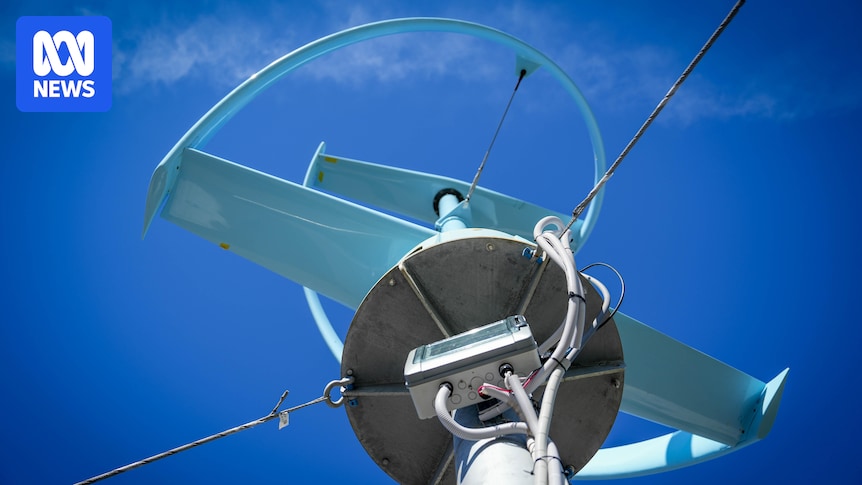On a major construction project south of Adelaide, testing has been underway on a new renewable wind energy source.
A small Australian-first vertical axis wind turbine has helped power a building site for crews working on the duplication of Main South Road between Aldinga and Sellicks beaches.
The developers of the turbine — which is just a fraction of the size of the wind turbines that dominate rural landscapes across Australia — could become part of the country’s renewable energy mix, providing power to businesses and potentially homes.
Flinders University has been working on the project for several years with company VAWT-X Energy.
Dr Amir Zanj says the team has overcome challenges “but yet a lot remains”. (ABC News: Brant Cumming)
Mechanical and aerospace engineer Dr Amir Zanj said the recent three-month trial had been positive, but that a lot more work and financial investment would be required.
“Without this technology being fully completed, still in the prototype level, we’ve received several requests from wineries … small manufacturers, small businesses and farmers,” Dr Zanj said.
The project has been funded with support from both federal and state governments, as well as a private investor.
“Without all these elements around the table, making something of this scale would be impossible,” Dr Zanj said.
Those behind the project hope the turbine could become part of the country’s renewable energy mix. (ABC News: Brant Cumming)
The 6-kilowatt wind turbine was used to power CPB Contractors’s construction site, and project manager Andrew Coonan said that there were advantages to having an energy source that can potentially run all day.
“Obviously the sun doesn’t shine 24 hours of the day … so we really see this as integrating into the mix of energy sources,” Mr Coonan said.
“Our compounds typically are powered by fossil fuels and having to tap into the [electricity] network, so having the ability to use wind power, solar power, sometimes there’s bio-fuel generators that can be used as well.
“Having a real mix in there, means we can get away from fossil fuels for our projects.”
Andrew Coonan says the turbine could become part of the mix of energy sources used. (ABC News: Brant Cumming)
Aim for commercial version to be ready next year
VAWT-X Energy managing director Gary Andrews said it had taken several years to create the current prototype, but he hoped he would have a product ready for manufacture within 12 months.
“The aim is to learn from it to see what faults there are and find solutions to fix those and have a commercial version by early next year,” Mr Andrews said.
“Solar only operates during the day, so if you want to go off-grid, ideally, you want to be able to have the potential to be able to generate electricity 24/7.
“So if you have solar and a wind turbine, then you’re potentially getting electricity day and night.”
Gary Andrews hopes to start manufacturing the turbines within a year. (ABC News: Brant Cumming)
Mr Andrews said he hoped to be able to manufacture locally in South Australia and wants to keep the cost to around $36,000, plus installation.
“We hope that this will be adopted across Australia and elsewhere in the world as a form of distributed renewable energy,” Mr Andrews said.
The project has been given support from federal and South Australian governments, including a $300,000 grant from the Department of State Development.
Minister for Climate, Environment and Water, Susan Close, said the vertical axis wind turbine was an “exciting development”.
“This wind turbine is able to capture more energy from low wind, which means is more useful for longer,” she said.
“You would expect that the state that is the most switched on in Australia for wind and solar would see the most innovation, and that’s exactly what’s happening.”
Susan Close says the turbine is an “exciting development”. (ABC News: Carl Saville)
Small-scale turbines could fill the niche
David Burton, from Monash University’s Department of Mechanical and Aerospace Engineering, said large wind farms that use horizontal axis wind turbines have dominated the global wind energy market.
Mr Burton said they had been found to be more commercially viable than vertical axis options like the VAWT-X prototype.
“As a general rule, horizontal axis turbines are significantly more efficient than vertical axis wind turbines … so primarily that’s the challenge,” he said.
“There’s quite a large number of manufacturers who have delved into that [vertical] technology, previously … it’s not a new thing.
“The advantage of a vertical axis wind turbine is that it doesn’t need to face the wind so it tends to perform the same, regardless of the wind direction.”
But Mr Burton said smaller scale turbines could potentially be the best way for the vertical technology to find its niche.
“If I was to look at a place for vertical axis wind then it’s in the area that they’re targeting, that sort of application seems to be the most logical,” he said.
“That seems to be where the technology is most likely to succeed, at least at this stage.”

